Input interpretation

Br_2 bromine + KF potassium fluoride ⟶ KBr potassium bromide + F_2 fluorine
Balanced equation
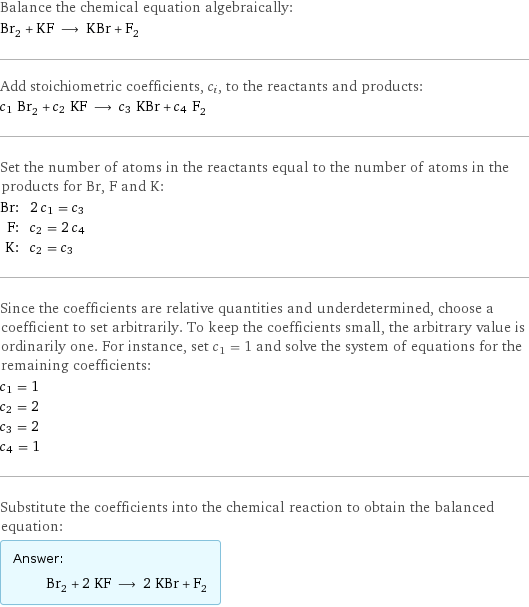
Balance the chemical equation algebraically: Br_2 + KF ⟶ KBr + F_2 Add stoichiometric coefficients, c_i, to the reactants and products: c_1 Br_2 + c_2 KF ⟶ c_3 KBr + c_4 F_2 Set the number of atoms in the reactants equal to the number of atoms in the products for Br, F and K: Br: | 2 c_1 = c_3 F: | c_2 = 2 c_4 K: | c_2 = c_3 Since the coefficients are relative quantities and underdetermined, choose a coefficient to set arbitrarily. To keep the coefficients small, the arbitrary value is ordinarily one. For instance, set c_1 = 1 and solve the system of equations for the remaining coefficients: c_1 = 1 c_2 = 2 c_3 = 2 c_4 = 1 Substitute the coefficients into the chemical reaction to obtain the balanced equation: Answer: | | Br_2 + 2 KF ⟶ 2 KBr + F_2
Structures

+ ⟶ +
Names

bromine + potassium fluoride ⟶ potassium bromide + fluorine
Reaction thermodynamics
Enthalpy
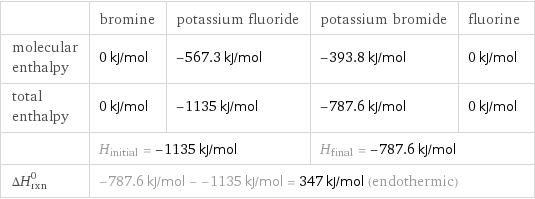
| bromine | potassium fluoride | potassium bromide | fluorine molecular enthalpy | 0 kJ/mol | -567.3 kJ/mol | -393.8 kJ/mol | 0 kJ/mol total enthalpy | 0 kJ/mol | -1135 kJ/mol | -787.6 kJ/mol | 0 kJ/mol | H_initial = -1135 kJ/mol | | H_final = -787.6 kJ/mol | ΔH_rxn^0 | -787.6 kJ/mol - -1135 kJ/mol = 347 kJ/mol (endothermic) | | |
Gibbs free energy
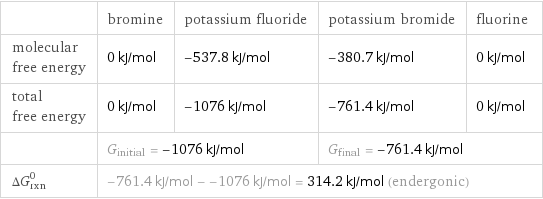
| bromine | potassium fluoride | potassium bromide | fluorine molecular free energy | 0 kJ/mol | -537.8 kJ/mol | -380.7 kJ/mol | 0 kJ/mol total free energy | 0 kJ/mol | -1076 kJ/mol | -761.4 kJ/mol | 0 kJ/mol | G_initial = -1076 kJ/mol | | G_final = -761.4 kJ/mol | ΔG_rxn^0 | -761.4 kJ/mol - -1076 kJ/mol = 314.2 kJ/mol (endergonic) | | |
Equilibrium constant
![Construct the equilibrium constant, K, expression for: Br_2 + KF ⟶ KBr + F_2 Plan: • Balance the chemical equation. • Determine the stoichiometric numbers. • Assemble the activity expression for each chemical species. • Use the activity expressions to build the equilibrium constant expression. Write the balanced chemical equation: Br_2 + 2 KF ⟶ 2 KBr + F_2 Assign stoichiometric numbers, ν_i, using the stoichiometric coefficients, c_i, from the balanced chemical equation in the following manner: ν_i = -c_i for reactants and ν_i = c_i for products: chemical species | c_i | ν_i Br_2 | 1 | -1 KF | 2 | -2 KBr | 2 | 2 F_2 | 1 | 1 Assemble the activity expressions accounting for the state of matter and ν_i: chemical species | c_i | ν_i | activity expression Br_2 | 1 | -1 | ([Br2])^(-1) KF | 2 | -2 | ([KF])^(-2) KBr | 2 | 2 | ([KBr])^2 F_2 | 1 | 1 | [F2] The equilibrium constant symbol in the concentration basis is: K_c Mulitply the activity expressions to arrive at the K_c expression: Answer: | | K_c = ([Br2])^(-1) ([KF])^(-2) ([KBr])^2 [F2] = (([KBr])^2 [F2])/([Br2] ([KF])^2)](../image_source/8dca3cd6bf7620be749eb967da0fe7bd.png)
Construct the equilibrium constant, K, expression for: Br_2 + KF ⟶ KBr + F_2 Plan: • Balance the chemical equation. • Determine the stoichiometric numbers. • Assemble the activity expression for each chemical species. • Use the activity expressions to build the equilibrium constant expression. Write the balanced chemical equation: Br_2 + 2 KF ⟶ 2 KBr + F_2 Assign stoichiometric numbers, ν_i, using the stoichiometric coefficients, c_i, from the balanced chemical equation in the following manner: ν_i = -c_i for reactants and ν_i = c_i for products: chemical species | c_i | ν_i Br_2 | 1 | -1 KF | 2 | -2 KBr | 2 | 2 F_2 | 1 | 1 Assemble the activity expressions accounting for the state of matter and ν_i: chemical species | c_i | ν_i | activity expression Br_2 | 1 | -1 | ([Br2])^(-1) KF | 2 | -2 | ([KF])^(-2) KBr | 2 | 2 | ([KBr])^2 F_2 | 1 | 1 | [F2] The equilibrium constant symbol in the concentration basis is: K_c Mulitply the activity expressions to arrive at the K_c expression: Answer: | | K_c = ([Br2])^(-1) ([KF])^(-2) ([KBr])^2 [F2] = (([KBr])^2 [F2])/([Br2] ([KF])^2)
Rate of reaction
![Construct the rate of reaction expression for: Br_2 + KF ⟶ KBr + F_2 Plan: • Balance the chemical equation. • Determine the stoichiometric numbers. • Assemble the rate term for each chemical species. • Write the rate of reaction expression. Write the balanced chemical equation: Br_2 + 2 KF ⟶ 2 KBr + F_2 Assign stoichiometric numbers, ν_i, using the stoichiometric coefficients, c_i, from the balanced chemical equation in the following manner: ν_i = -c_i for reactants and ν_i = c_i for products: chemical species | c_i | ν_i Br_2 | 1 | -1 KF | 2 | -2 KBr | 2 | 2 F_2 | 1 | 1 The rate term for each chemical species, B_i, is 1/ν_i(Δ[B_i])/(Δt) where [B_i] is the amount concentration and t is time: chemical species | c_i | ν_i | rate term Br_2 | 1 | -1 | -(Δ[Br2])/(Δt) KF | 2 | -2 | -1/2 (Δ[KF])/(Δt) KBr | 2 | 2 | 1/2 (Δ[KBr])/(Δt) F_2 | 1 | 1 | (Δ[F2])/(Δt) (for infinitesimal rate of change, replace Δ with d) Set the rate terms equal to each other to arrive at the rate expression: Answer: | | rate = -(Δ[Br2])/(Δt) = -1/2 (Δ[KF])/(Δt) = 1/2 (Δ[KBr])/(Δt) = (Δ[F2])/(Δt) (assuming constant volume and no accumulation of intermediates or side products)](../image_source/01b379b193fc9e0ca92e234bd128ef46.png)
Construct the rate of reaction expression for: Br_2 + KF ⟶ KBr + F_2 Plan: • Balance the chemical equation. • Determine the stoichiometric numbers. • Assemble the rate term for each chemical species. • Write the rate of reaction expression. Write the balanced chemical equation: Br_2 + 2 KF ⟶ 2 KBr + F_2 Assign stoichiometric numbers, ν_i, using the stoichiometric coefficients, c_i, from the balanced chemical equation in the following manner: ν_i = -c_i for reactants and ν_i = c_i for products: chemical species | c_i | ν_i Br_2 | 1 | -1 KF | 2 | -2 KBr | 2 | 2 F_2 | 1 | 1 The rate term for each chemical species, B_i, is 1/ν_i(Δ[B_i])/(Δt) where [B_i] is the amount concentration and t is time: chemical species | c_i | ν_i | rate term Br_2 | 1 | -1 | -(Δ[Br2])/(Δt) KF | 2 | -2 | -1/2 (Δ[KF])/(Δt) KBr | 2 | 2 | 1/2 (Δ[KBr])/(Δt) F_2 | 1 | 1 | (Δ[F2])/(Δt) (for infinitesimal rate of change, replace Δ with d) Set the rate terms equal to each other to arrive at the rate expression: Answer: | | rate = -(Δ[Br2])/(Δt) = -1/2 (Δ[KF])/(Δt) = 1/2 (Δ[KBr])/(Δt) = (Δ[F2])/(Δt) (assuming constant volume and no accumulation of intermediates or side products)
Chemical names and formulas
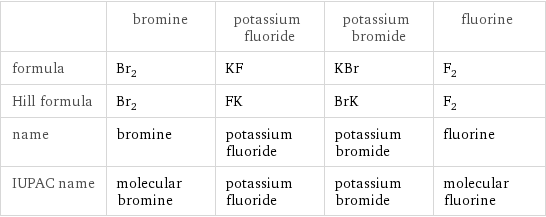
| bromine | potassium fluoride | potassium bromide | fluorine formula | Br_2 | KF | KBr | F_2 Hill formula | Br_2 | FK | BrK | F_2 name | bromine | potassium fluoride | potassium bromide | fluorine IUPAC name | molecular bromine | potassium fluoride | potassium bromide | molecular fluorine
Substance properties
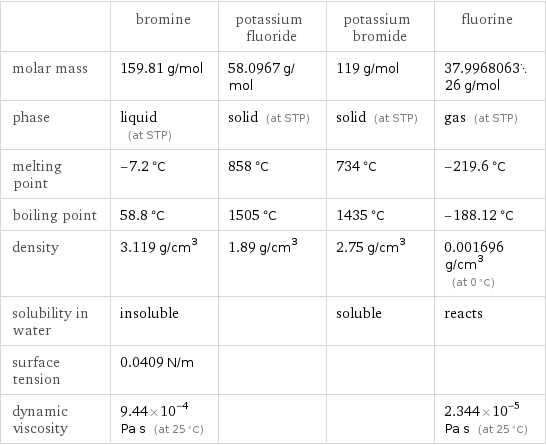
| bromine | potassium fluoride | potassium bromide | fluorine molar mass | 159.81 g/mol | 58.0967 g/mol | 119 g/mol | 37.996806326 g/mol phase | liquid (at STP) | solid (at STP) | solid (at STP) | gas (at STP) melting point | -7.2 °C | 858 °C | 734 °C | -219.6 °C boiling point | 58.8 °C | 1505 °C | 1435 °C | -188.12 °C density | 3.119 g/cm^3 | 1.89 g/cm^3 | 2.75 g/cm^3 | 0.001696 g/cm^3 (at 0 °C) solubility in water | insoluble | | soluble | reacts surface tension | 0.0409 N/m | | | dynamic viscosity | 9.44×10^-4 Pa s (at 25 °C) | | | 2.344×10^-5 Pa s (at 25 °C)
Units
